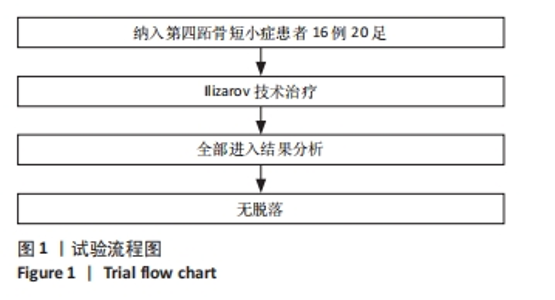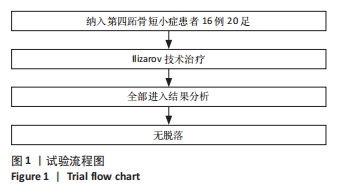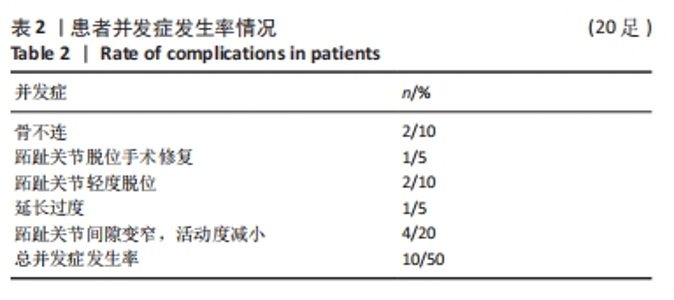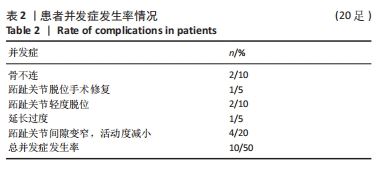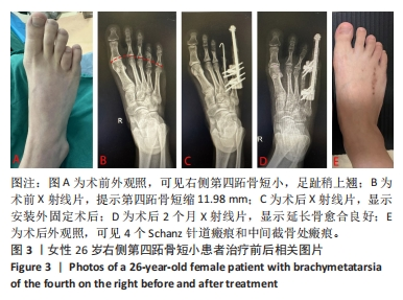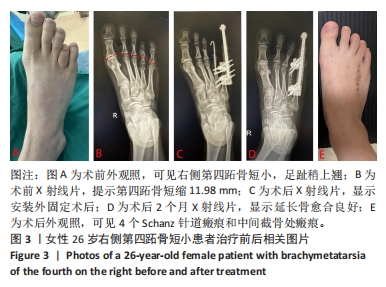Chinese Journal of Tissue Engineering Research ›› 2025, Vol. 29 ›› Issue (33): 7217-7222.doi: 10.12307/2025.821
Previous Articles Next Articles
Ilizarov technique for treatment of congenital brachymetatarsia of the fourth: subgroup analysis of prolongation ratio
Liang Jiachang, Guan Hua, Feng Enhui, Chen Pu, Huang Weiming, He Jianbo, Xie Jiewei
- Department of Foot and Ankle Trauma, Guangdong Provincial Hospital of Traditional Chinese Medicine, Guangzhou 510120, Guangdong Province, China
-
Received:2024-05-30Accepted:2024-07-20Online:2025-11-28Published:2025-04-12 -
Contact:Xie Jiewei, MS, Associate chief physician, Department of Foot and Ankle Trauma, Guangdong Provincial Hospital of Traditional Chinese Medicine, Guangzhou 510120, Guangdong Province, China -
About author:Liang Jiachang, MS, Physician, Department of Foot and Ankle Trauma, Guangdong Provincial Hospital of Traditional Chinese Medicine, Guangzhou 510120, Guangdong Province, China -
Supported by:Guangdong Provincial Hospital of Traditional Chinese Medicine of Academy of Sciences Technology Research Talent of Special Project, No. BJ2022YL13 (to XJW); Soft Science Research Project in Guangdong Province, No. 2020A1414040031 (to XJW)
CLC Number:
Cite this article
Liang Jiachang, Guan Hua, Feng Enhui, Chen Pu, Huang Weiming, He Jianbo, Xie Jiewei. Ilizarov technique for treatment of congenital brachymetatarsia of the fourth: subgroup analysis of prolongation ratio[J]. Chinese Journal of Tissue Engineering Research, 2025, 29(33): 7217-7222.
share this article
Add to citation manager EndNote|Reference Manager|ProCite|BibTeX|RefWorks
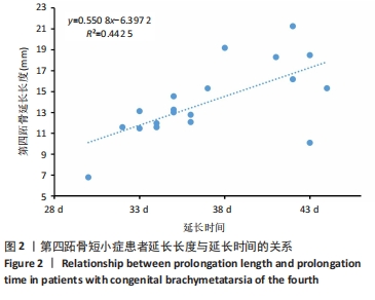
2.3 临床与影像学结果 患者均获得随访,随访时间(9.15±6.86)个月(4-26个月)。患者术前第四跖骨长度为(43.51±3.75) mm (35.32-50.18 mm),第四跖骨短缩长度为(12.53±2.82) mm (5.62-16.9 mm),延长长度为(13.90±3.47) mm (6.78-21.26 mm),延长比例为(32.30±9.10)%,延长时间为(36.95±4.12) d (30-44 d),带外固定支架时间(102.30±32.74) d (67-164 d)。 AOFAS评分从术前的(71.40±5.66)分提高到末次随访的(85.30±8.838)分,差异有显著性意义(t=0.763,P < 0.01)。12例患者均对延长手术表示满意,2例患者骨不连翻修及2例患者跖趾关节脱位行翻修手术表示不满意。此外,延长时间与延长长度呈正相关(y=0.550 8x-6.397 2,R2=0.442 5),详见图2。"
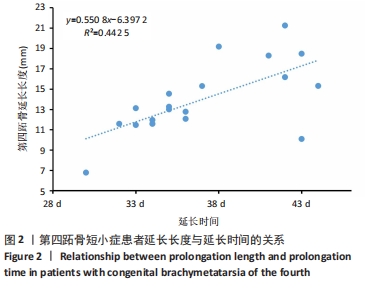
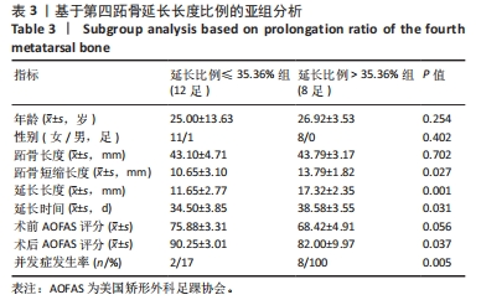
2.5 基于第四跖骨延长长度比例的亚组分析 对20只足的第四跖骨延长长度比例按照从高到低顺序排列,根据术后并发症情况依次进行卡方检验分析,当延长比例为35.36%这一界点时,延长长度比例≤35.36%组的并发症发生率(17%)较术后延长比例> 35.36%组(100%)低,且差异有显著性意义(t=14.008,P < 0.05),因此以延长比例小于35.36%为宜。 20只足中12只足第四跖骨延长长度比例≤35.36%,延长长度为(11.65±2.77) mm;8只足术后延长比例> 35.36%,延长长度为(17.32±2.35) mm,两组相比差异有显著性意义(t=-4.455,P < 0.01)。两亚组患者在年龄、性别、跖骨长度方面差异无显著性意义(P > 0.05),具有可比性。术后延长长度比例≤35.36%组的术后AOFAS评分(90.25±3.01)分高于术后延长比例> 35.36%组(82.00±9.97)分,差异有显著性意义(t=2.254,P < 0.05)。 所以Ilizarov技术治疗先天性第四跖骨短小症手术可显著改善患者足部畸形,尤其适用于治疗延长长度比例不超过35.36%的患者,并发症发生率低,效果满意。详见表3。"
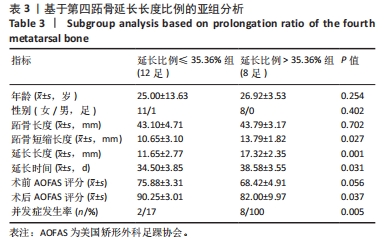
| [1] KIM HT, LEE SH, YOO CI, et al. The management of brachymetatarsia. J Bone Joint Surg. J Bone Joint Surg Br. 2003;85(5):683-690. [2] SCHIMIZZI A, BRAGE M. Brachymetatarsia. Foot Ankle Clin. 2004;9(3): 555-570. [3] LEE KB, PARK HW, CHUNG JY, et al. Comparison of the outcomes of distraction osteogenesis for first and fourth brachymetatarsia.J Bone Joint Surg Am. 2010;92(16):2709-2718. [4] THOMAS MA, SIDDIQUI NA, MILLONIG KJ, et al. The Role of the Shortened Proximal Phalanx in the Setting of Brachymetatarsia. J Foot Ankle Surg. 2023;62(1):129-131. [5] URANO Y, KOBAYASHI A. Bone-lengthening for shortness of the fourth toe. J Bone Joint Surg Am. 1978;60(1):91-93. [6] SHECAIRA AP, FERNANDES RMP. Brachymetatarsia: One-stage Versus Two-Stage Procedures. Foot Ankle Clin. 2019;24(4):677-687. [7] LAMM BM. Percutaneous distraction osteogenesis for treatment of brachymetatarsia. J Foot Ankle Surg. 2010;49(2):197-204. [8] SIDDIQUI NA, MATEEN S, THOMAS MA, et al. Comparing Outcomes of Acute Versus Gradual Surgical Correction in Brachymetatarsia. J Foot Ankle Surg. 2024;63(2):281-285. [9] FUSINI F, ALESSANDRO M, RAVA A, et al. Aetiology, diagnosis, and treatment of brachymetatarsia: a narrative review. Musculoskelet Surg. 2022;106(2):99-109. [10] CORDOBA-FERNANDEZ A, VERA-GOMEZ ML. Literature Review on Brachymetatarsia. Orthop Nurs. 2018;37(5):292-302. [11] SMOLLE E, SCHEIPL S, LEITHNER A, et al. Management of congenital fourth brachymetatarsia by additive autologous lengthening osteotomy (AALO): a case series. Foot Ankle Int. 2015;36(3):325-329. [12] DESAI A, LIDDER S, R ARMITAGE A, et al. Brachymetatarsia of the fourth metatarsal, lengthening scarf osteotomy with bone graft. Orthop Rev. 2013;5(3):e21. [13] HUNG WC, CHEN CH, LIN CH, et al. Subacute two stage metatarsal lengthening with gradual distraction for brachymetatarsia: A consecutive case series and literature review. Foot Ankle Surg. 2023; 29(1):86-89. [14] LEE KB, YANG HK, CHUNG JY, et al. How to avoid complications of distraction osteogenesis for first brachymetatarsia. Acta Orthop. 2009; 80(2):220-225. [15] LAMM BM, LAMM TB. Brachymetatarsia: A Classification for Surgical Treatment. J Foot Ankle Surg. 2023;62(1):132-149. [16] 苏惠强,王江波,张勇,等. 一期延长与渐进性延长治疗先天性跖骨短小症的疗效比较[J]. 实用骨科杂志,2023,29(2):116-120. [17] BARBIER D, NERETIN A, JOURNEAU P, et al. Gradual Metatarsal Lengthening by External Fixation: A New Classification of Complications and a Stable Technique to Minimize Severe Complications. Foot Ankle Int. 2015;36(11):1369-1377. [18] LAMM BM, GOURDINE-SHAW MC. Problems, obstacles, and complications of metatarsal lengthening for the treatment of brachymetatarsia. Clin Podiatr Med Surg. 2010;27(4):561-582. [19] 邓伟,刘熹,陈宇,等. 微创截骨结合Ilizarov技术治疗先天性第4跖骨短小症[J]. 中华骨与关节外科杂志,2021,14(6):533-537. [20] WOO SH, BANG CY, AHN HC, et al. Anatomical reconstruction of the fourth brachymetatarsia with one-stage iliac bone and cartilage cap grafting. J Plast Reconstr Aesthet Surg. 2017;70(5):666-672. [21] MUNUERA MARTIEZ PV, LAFUENTE SOTILOS G, DOMINGUEZ MALDONADO G, et al. Morphofunctional study of brachymetatarsia of the fourth metatarsal. J Am Podiatr Med Assoc. 2004;94(4):347-352. [22] LEE WC, SUH JS, MOON JS, et al. Treatment of brachymetatarsia of the first and fourth ray in adults. Foot Ankle Int. 2009;30(10):981-985. [23] DAVIDSON RS. Metatarsal lengthening. Foot Ankle Clin. 2001;6(3):499-518. [24] 杨小龙,范柯君,徐红军,等. 3例双侧先天性第4跖骨短小症家系分析[J]. 临床骨科杂志,2023,26(3):456. [25] JAGANI N, FAGIR M, DALAL N, et al. Metatarsal lengthening by distraction osteogenesis for brachymetatarsia in paediatric patients: is it safe and effective? Eur J Orthop Surg Traumatol. 2024;34(4):1839-1844. [26] BARIK S, FARR S. Brachymetacarpia and brachymetatarsia: do we need to operate? EFORT Open Rev. 2021;6(1):15-23. [27] FOX JS. Treatment of brachymetatarsia by the callus distraction method. J Foot Ankle Surg. 1998;37(5):391-395,447. [28] CHOI IH, CHUNG MS, BAEK GH, et al. Metatarsal lengthening in congenital brachymetatarsia: one-stage lengthening versus lengthening by callotasis. J Pediatr Orthop. 1999;19(5):660-664. [29] GILBODY J, NAYAGAM S. Lengthening of the first metatarsal through an arthrodesis site for treatment of brachymetatarsia: a case report. J Foot Ankle Surg. 2008;47(6):559-564. [30] MAGNAN B, BRAGANTINI A, REGIS D, et al. Metatarsal lengthening by callotasis during the growth phase. J Bone Joint Surg Br. 1995;77(4):602-607. [31] MACHADO FILHO A, COSTA GFO, FARIA AADS, et al. Treatment of Brachymetatarsia by Distraction Osteogenesis Using Monolateral External Fixator. Rev Bras Ortop. 2022;57(1):75-81. [32] ARATA J, KUMAKIRI M, YAMASHITA T, et al. Nonincisional Osteotomy for Gradual Lengthening by Callus Distraction for Congenital Brachymetatarsia. J Foot Ankle Surg. 2021;60(6):1293-1296. [33] KLAUSER HO. The Surgical Treatment of Brachymetatarsia. Foot Ankle Clin. 2021;26(4):685-704. [34] ARCERI A, MAZZOTTI A, ZIELLI SO, et al. What’s the evidence on surgical treatment for congenital brachymetatarsia: A systematic review and meta-analysis. J Orthop. 2024;49:107-116. [35] HOSNY GA, AHMED AS. Distraction osteogenesis of fourth brachymetatarsia. Foot Ankle Surg. 2016;22(1):12-16. [36] JONES MD, PINEGAR DM, RINCKER SA. Callus Distraction Versus Single-Stage Lengthening With Bone Graft for Treatment of Brachymetatarsia: A Systematic Review. J Foot Ankle Surg. 2015;54(5):927-931. [37] 聂少波,吴韬光,郝明,等. 基于迷你单臂外架的手风琴技术治疗先天性跖骨短小症的临床疗效[J]. 武警医学,2022,33(5):395-398. [38] WADA A, BENSAHEL H, TAKAMURA K, et al. Metatarsal lengthening by callus distraction for brachymetatarsia. J Pediatr Orthop B. 2004;13(3): 206-210. [39] 顾建明,杜辉,崔雅南,等. 微创截骨单臂架骨延长术治疗先天性跖骨短小症[J]. 骨科,2021,12(3):195-199. [40] NERETIN AS, MENSHCHIKOVA TI. Value of ultrasonography and radiography for the study of bone regeneration in lengthening of the fourth ray in brachymetatarsia. Foot Ankle Surg. 2021;27(4):432-438. |
| [1] | Xu Hao, Ding Lu, Li Xiao. Investigating the effect of the mechanical wear on abutment screw in Morse taper connection implant implant system by using finite element analysis [J]. Chinese Journal of Tissue Engineering Research, 2025, 29(在线): 1-9. |
| [2] | Jing Ruyi, Chen Yingxin, Cao Lei . Prognosis of deep lamellar keratoplasty versus penetrating keratoplasty in the treatment of stromal corneal dystrophy [J]. Chinese Journal of Tissue Engineering Research, 2025, 29(8): 1626-1633. |
| [3] | Wang Lei, Li Chengsong, Zhang Shenshen, Wang Qing. Finite element analysis of biomechanical characteristics of three internal fixation methods in treatment of inferior patellar fracture [J]. Chinese Journal of Tissue Engineering Research, 2025, 29(33): 7048-7054. |
| [4] | Wang Rongqiang, Yang Liu, Wu Xiangkun, Shang Lilin. Analysis of factors associated with prognosis of osteoporosis patients after hip arthroplasty and construction of Nomogram prediction model [J]. Chinese Journal of Tissue Engineering Research, 2025, 29(33): 7137-7142. |
| [5] | Abuduainijiang·Abulimiti, Alimu·Mamuti, Li Simi. Artificial femoral head replacement for femoral neck fracture in the elderly: validation of a risk prediction model for hip dysfunction [J]. Chinese Journal of Tissue Engineering Research, 2025, 29(33): 7143-7149. |
| [6] | Yang Wanzhong, Ma Rong, Guo Wei, Wang Zhiqiang, Yang Wei, Chen Zhen, Wang Zemin, Zhang Honglai, Ge Zhaohui. One-stage posterior hemivertebra resection and pedicle screw fixation in treatment of congenital scoliosis: a 2-year follow-up of correction effect [J]. Chinese Journal of Tissue Engineering Research, 2025, 29(33): 7173-7180. |
| [7] | Jiang Zehua, Du Wenjun, Ren Zhishuai, Cui Haojun, Zhu Rusen. Percutaneous vertebroplasty via Kambin's triangle for treatment of osteoporotic compression fractures: evaluation of safety and effectiveness [J]. Chinese Journal of Tissue Engineering Research, 2025, 29(33): 7181-7188. |
| [8] | Yan Jinlian, Xu Zhengquan, Wei Renjie, Wang Yehua. Hip joint function recovery and prediction model construction after proximal femoral nail antirotation for intertrochanteric fractures [J]. Chinese Journal of Tissue Engineering Research, 2025, 29(33): 7189-7195. |
| [9] | Cao Yong, Li Xin, Chen Zhigang, Gu Honglin, Lyu Shujun. Compensatory alignment changes of cervical and thoracic spine after correction of lumbar degenerative scoliosis [J]. Chinese Journal of Tissue Engineering Research, 2025, 29(33): 7196-7202. |
| [10] | Liao Qiyu, Ru Jiangying. Complications of intra-prosthetic dissociation after hip arthroplasty [J]. Chinese Journal of Tissue Engineering Research, 2025, 29(33): 7241-7249. |
| [11] | Zhao Yihan, Sun Xuhang, Zhao Lin, Jiang Shiqing. Effects and mechanisms of exosomal miRNA in treatment of multiple myeloma [J]. Chinese Journal of Tissue Engineering Research, 2025, 29(31): 6743-6752. |
| [12] | Shi Lei, Shi Song, Lu Yue, Tao Ran, Ma Hongdong. Comparison of unicondylar knee arthroplasty and high tibial osteotomy in treatment of medial knee osteoarthritis [J]. Chinese Journal of Tissue Engineering Research, 2025, 29(3): 503-509. |
| [13] | Chen Zhen, Chen Xi, Li Xiaoting, Chen Daxin, Hong Weiwu. Comparison of medial-lateral and lateral-only fixation for pediatric supracondylar humeral fractures: a systematic review and meta-analysis [J]. Chinese Journal of Tissue Engineering Research, 2025, 29(27): 5924-5932. |
| [14] | Pan Hongyu, Li Hongtao, Xiao Changming, Li Sen. Biomechanical analysis on treatment of different types of osteoporotic vertebral compression fractures with individualized precise puncture vertebral augmentation [J]. Chinese Journal of Tissue Engineering Research, 2025, 29(27): 5773-5784. |
| [15] | Wang Yijun, Zheng Kai, Zhang Lianfang, Zhu Feng, Zhang Weicheng, Li Rongqun, Zhou Jun, Xu Yaozeng. Navigation-assisted total knee arthroplasty using functional alignment restores constitutional alignment and joint line obliquity [J]. Chinese Journal of Tissue Engineering Research, 2025, 29(27): 5810-5818. |
| Viewed | ||||||
|
Full text |
|
|||||
|
Abstract |
|
|||||
